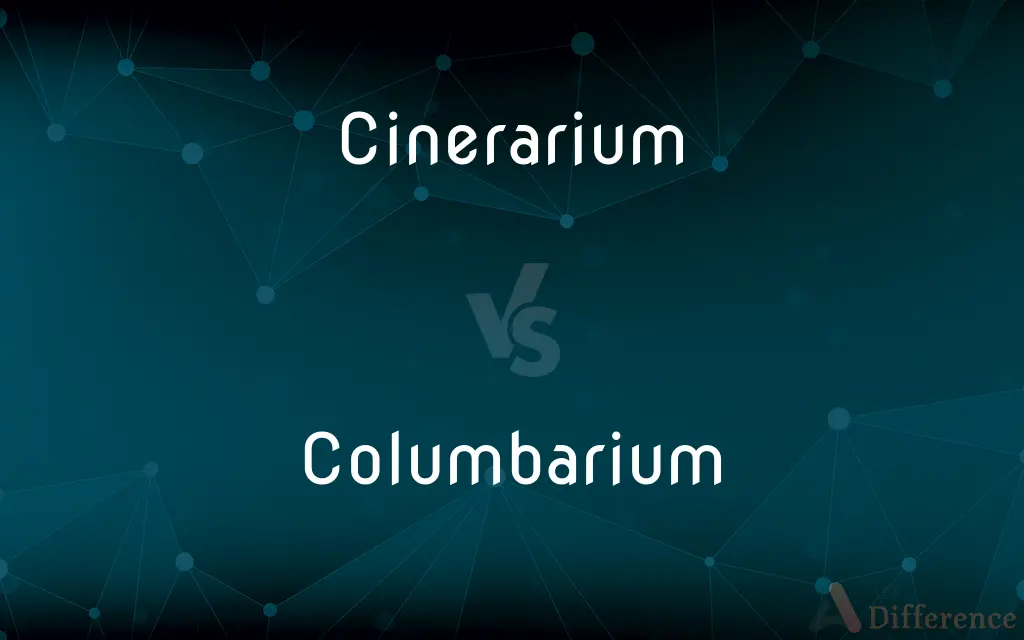Cinerarium vs. Columbarium — What's the Difference?
Edited by Tayyaba Rehman — By Fiza Rafique — Updated on April 23, 2024
A cinerarium is a storage place specifically for urns containing ashes of the deceased, focusing on ground-level or underground facilities, whereas a columbarium consists of wall spaces called niches designed to hold urns, often part of larger buildings.

Difference Between Cinerarium and Columbarium
Table of Contents
ADVERTISEMENT
Key Differences
A cinerarium is typically designed as a secluded area, either outdoor or within a building, dedicated to housing urns filled with cremated remains. Whereas, a columbarium is a structure with multiple niches, each serving as a private, often sealed space for individual urns, frequently seen in cemeteries and memorial parks.
Cinerariums are often less structured in terms of individual spaces, providing a communal setting for ashes, which may not be individually marked. On the other hand, columbariums offer a more organized arrangement, with niches labeled and sometimes decorated with memorabilia or nameplates.
While cinerariums may be simpler and less costly due to their communal nature, columbariums provide a more personalized memorial option, reflecting a higher level of individual recognition and remembrance.
Cinerariums can be more flexible in terms of placement and design, adapting to various environments such as gardens or natural settings. Columbariums, however, are built with architectural considerations, often enhancing a cemetery’s aesthetics and can be significant elements of funeral architecture.
In terms of access, cinerariums typically provide a more open environment, which can be more accessible for general visitation. Columbariums are usually more controlled, with specific hours for visitation and sometimes even restrictions on access to ensure privacy and security.
ADVERTISEMENT
Comparison Chart
Definition
A place for storing cremation urns, often less structured.
A structure with niches for storing cremation urns.
Location
Can be underground or in a secluded outdoor area.
Typically part of larger buildings or cemeteries.
Personalization
Generally communal and less personalized.
Individual niches that can be personalized.
Cost
Often lower due to simpler design.
Higher due to architectural and space considerations.
Access and Visitation
Usually open and easily accessible.
Controlled access with specific visitation hours.
Compare with Definitions
Cinerarium
A repository for cremation ashes, typically communal.
The family chose to place her ashes in the park's cinerarium.
Columbarium
May require specific maintenance and rules.
The columbarium rules stipulate no artificial flowers in the niches.
Cinerarium
An outdoor or indoor area designated for holding urns.
The garden cinerarium was serene and beautifully landscaped.
Columbarium
Offers personalized spaces for cremated remains.
Each niche in the columbarium is crafted with a nameplate and vase.
Cinerarium
A less structured space for cremated remains.
They preferred the simplicity of the cinerarium for their final resting place.
Columbarium
A building or wall with niches for urns.
Their columbarium niche was adorned with flowers and photos.
Cinerarium
May not include individual markings for ashes.
His ashes were placed in the communal cinerarium, with no individual marker.
Columbarium
Contains individually secured niches.
The family visited her secured niche in the columbarium.
Cinerarium
Often part of a cemetery or standalone.
The new cemetery features a cinerarium beside the chapel.
Columbarium
Architectural feature of cemeteries.
The columbarium at the heart of the cemetery stands as a testament to modern design.
Cinerarium
A place for keeping the ashes of a cremated body.
Columbarium
A columbarium (; pl. columbaria) is a structure for the respectful and usually public storage of funerary urns, holding cremated remains of the deceased.
Cinerarium
A place or receptacle for depositing the ashes of cremated people.
Columbarium
A vault with niches for urns containing ashes of the dead.
Cinerarium
A niche for a funeral urn containing the ashes of the cremated dead
Columbarium
One of the niches in such a vault.
Columbarium
A dovecote.
Columbarium
A pigeonhole in a dovecote.
Columbarium
(historical) A large, sometimes architecturally impressive building for housing a large colony of pigeons or doves, particularly those of ancien regime France.
Columbarium
A pigeonhole in such a dovecote.
Columbarium
A building, a vault or a similar place for the respectful and usually public storage of cinerary urns containing cremated remains.
Columbarium
A niche in such a building for housing urns.
Columbarium
A dovecote or pigeon house.
Columbarium
A niche for a funeral urn containing the ashes of the cremated dead
Columbarium
A sepulchral vault or other structure having recesses in the walls to receive cinerary urns
Common Curiosities
What kind of personalization is available in a columbarium?
Columbariums allow for personalization through individual niches that can be decorated with nameplates, photos, and other memorabilia.
Can you personalize a space in a cinerarium?
Personalization in a cinerarium is limited as it usually serves as a communal space for ashes without individual markers.
How do cinerariums differ from columbariums in terms of cost?
Cinerariums tend to be less expensive due to their simpler, communal design, while columbariums are costlier due to the need for individual niches and architectural elements.
Are there any specific rules for visiting a columbarium?
Yes, columbariums usually have specific visiting hours and rules regarding decorum and decorations to maintain the dignity of the site.
What is a columbarium?
A columbarium is a structure with individual niches, each designed to store an urn containing cremated remains.
Is a cinerarium a common choice for cremation memorials?
Yes, cinerariums are a common choice for those seeking a simple and often less expensive cremation memorial option.
What is a cinerarium?
A cinerarium is a place designated for storing urns that contain cremation ashes, often in a communal space.
Can columbarium niches be leased or purchased permanently?
Columbarium niches can often be leased for a specific period or purchased permanently, depending on the cemetery’s policies.
Can anyone visit a cinerarium?
Typically, cinerariums are open and accessible to the public, allowing anyone to visit.
Where are columbariums typically found?
Columbariums are often found within cemeteries, churches, or as standalone structures within memorial parks.
What makes columbariums a preferred option for some families?
The ability to personalize niches and the structured, secure environment make columbariums a preferred option for families wishing to create a lasting memorial.
Where are cinerariums typically located?
Cinerariums can be located within buildings or in outdoor settings such as gardens or natural areas.
Are cinerariums secure?
Security in a cinerarium can vary, but generally, they are open spaces with less controlled access compared to columbariums.
How do families choose between a cinerarium and a columbarium?
Families choose based on their preferences for personalization, cost considerations, and the desired type of memorial experience.
How does a columbarium enhance a cemetery’s aesthetics?
Columbariums often incorporate architectural design elements that contribute to the overall aesthetics and layout of a cemetery.
Share Your Discovery

Previous Comparison
Setting vs. Location
Next Comparison
Lizard vs. SalamanderAuthor Spotlight
Written by
Fiza RafiqueFiza Rafique is a skilled content writer at AskDifference.com, where she meticulously refines and enhances written pieces. Drawing from her vast editorial expertise, Fiza ensures clarity, accuracy, and precision in every article. Passionate about language, she continually seeks to elevate the quality of content for readers worldwide.
Edited by
Tayyaba RehmanTayyaba Rehman is a distinguished writer, currently serving as a primary contributor to askdifference.com. As a researcher in semantics and etymology, Tayyaba's passion for the complexity of languages and their distinctions has found a perfect home on the platform. Tayyaba delves into the intricacies of language, distinguishing between commonly confused words and phrases, thereby providing clarity for readers worldwide.














































